
Chords in A Major: Functions, Tips, and Examples for Beginners and Intermediates
Explore the chords in A Major and common chord progressions in A major. Written for music producers and music creators seeking to enhance their melodic and harmonic skills.
Introduction
A solid grasp of the chords within a key and the theory behind their effectiveness is crucial for both musicians and producers. This understanding streamlines the songwriting process and allows for more intentional and creative writing sessions.
This guide explores the chords of A major, starting with the A major scale and the triads built upon it. We'll then briefly discuss the diatonic seventh chords in the key signature. Lastly, we’ll delve into augmented, diminished, and suspended chords to expand your harmonic palette.
By the end, you'll have a strong grasp of the A major key, allowing you to create music with greater depth, intrigue, and movement.
Here's a preview of what you'll learn:
This article offers a step-by-step exploration of A major chords, explaining their functions and how to build compelling progressions to elevate your music.
The Basics of the A Major Scale
The A major scale, with its seven notes (A, B, C#, D, E, F#, G#), is the basis for A major chords and progressions. These notes, called diatonic notes, follow a specific pattern of whole and half steps, giving the A major scale its distinctive sound.

This same whole and half-step pattern also forms the basis of the Aeolian mode, more commonly known as the natural minor scale. (For an excellent explanation of music modes, check out Charles Cornell's video ).

Each note in the A major scale has a specific position, called a scale degree, which relates it to the tonic (the key's foundation). This position determines the note's harmonic function and character. Chords in A major are built on each of these scale degrees:
These scale degrees and their corresponding Roman numerals are crucial for understanding how chords function within the key.
For more in-depth music theory tutorials covering all key signatures, be sure to check out our blog!
A Major Chords and Their Functions in Music
Chords in A major are built using tertian harmony, which is based on intervals of thirds. The most common chord type, the triad, has three notes stacked in thirds:
A major has seven diatonic chords, each constructed from the A major scale. We'll explore these chords and their functions, along with common uses in songwriting and progressions.
The diatonic chords in A major are A major, B minor, C# minor, D major, E major, F# minor, and G# diminished.

This section explores A Major chords on the piano, their functions, and how they're commonly used in song progressions. The piano's layout makes building chords and recognizing alterations, such as those in augmented chords, particularly easy.
I: A Major
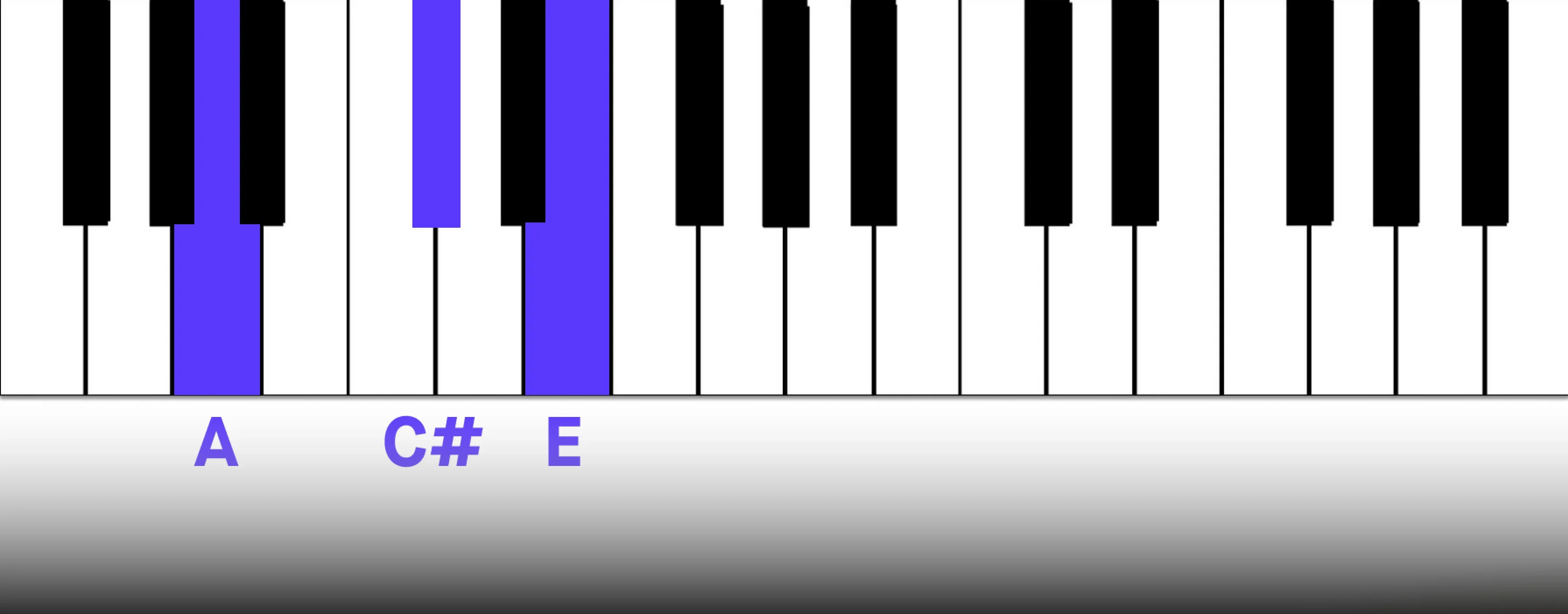
The A major chord, as the tonic, is the home chord, the point of rest and resolution. Everything else in the key relates to the tonic, either moving towards it or away from it. Its function is to provide a sense of stability, grounding the music and giving the listener a feeling of arrival.
The tonic's significance extends beyond just being a stable chord. It defines the key itself. All other chords in the key derive their meaning and function based on the tonic. It's the reference point for consonance and dissonance, the anchor that gives context to all other harmonic events.
Musically, the tonic is used to begin and end pieces or sections, providing a clear sense of closure. It can also be used throughout a piece to reinforce the key and provide moments of repose. In essence, the A major tonic is the harmonic bedrock of the key of A major, providing stability while defining the key's character.
Example:"Tomorrow Will Be Kinder"by The Secret Sisters establishes a strong sense of tonal stability by lingering on the A Major chord for a considerable duration at the beginning. The brief, almost hesitant move to the subdominant before returning to the tonic emphasizes the strength of the established tonal center.
This prolonged emphasis on the tonic makes each subsequent departure from it all the more significant while simultaneously reinforcing the sense of resolution and comfort upon each return.
ii: B Minor
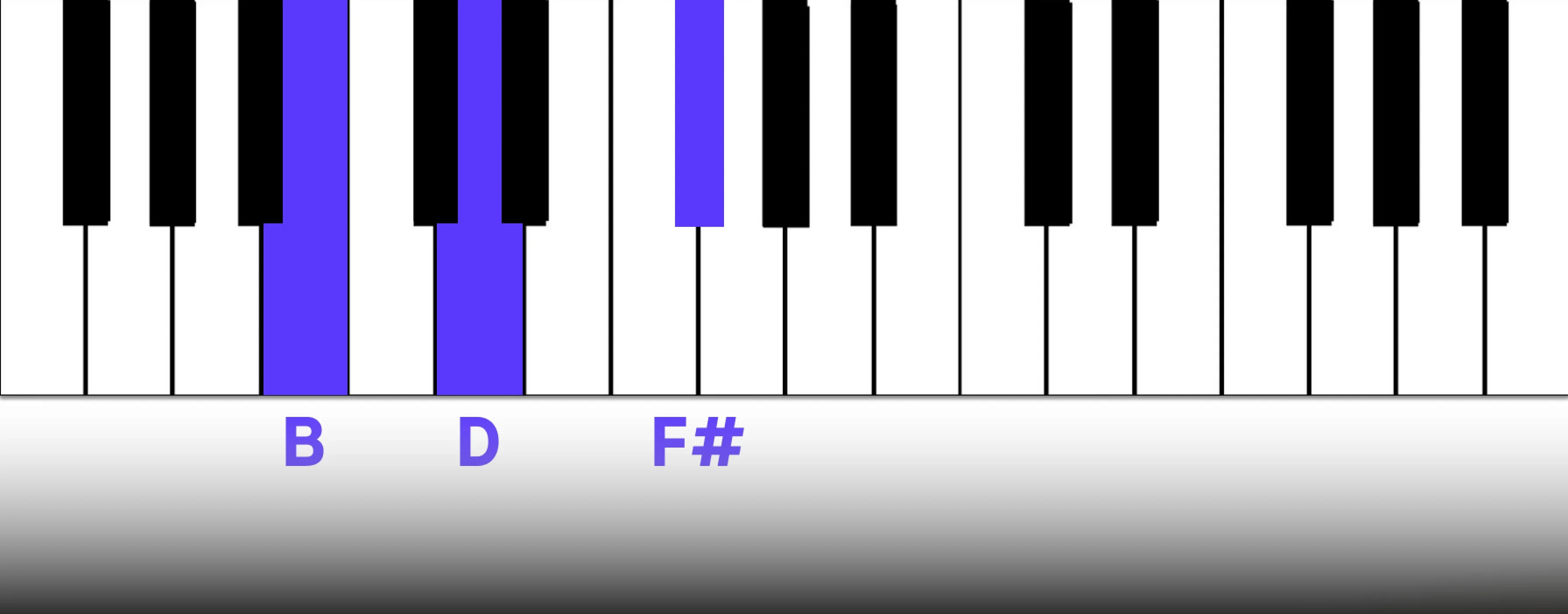
The supertonic is a vital ingredient for harmonic motion and color. It introduces a gentle tension, a slight lean away from the tonic, creating a sense of anticipation. This tension defines its role as a predominant chord, which often moves towards the dominant.
The B minor's minor quality brings a touch of introspection, a subtle shade of melancholy that contrasts beautifully with the major chords in the key. Think of it as a harmonic detour, a momentary pause that adds depth and interest before returning home. It's not a place of rest but rather a point of harmonic momentum.
Example: In the verse to The Beatles’ “Only a Northern Song” we hear a Minor ii chord with the predominant function as it leads to the dominant chord.
iii: C# Minor
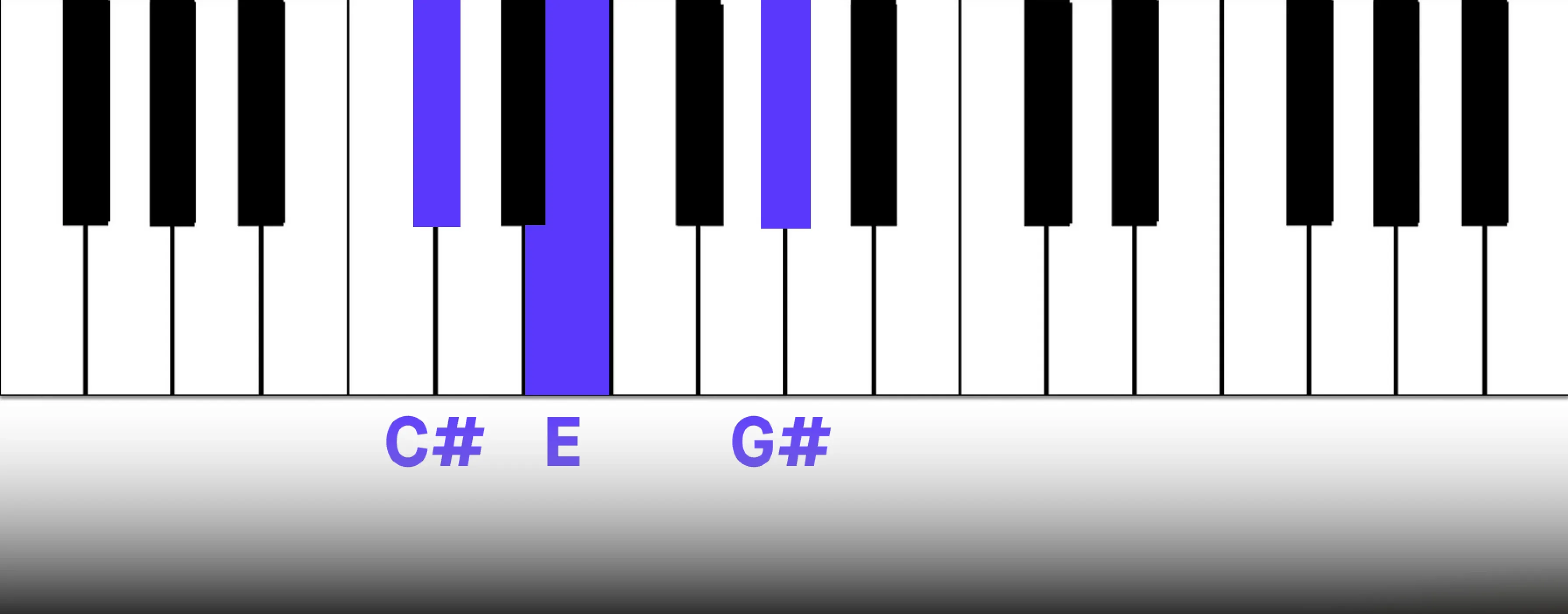
As the mediant, C# minor adds a distinct flavor to the harmony. It introduces a different shade of minor tonality compared to the supertonic, contributing a richer, more complex emotional depth. While not as strongly directional as the supertonic, it still creates a subtle tension, hinting at a resolution but often taking a less direct path.
The mediant can serve several purposes. It can act as a passing chord, connecting other chords in the progression. It can also be used to create contrast with the major chords, adding a touch of introspection or melancholy.
Sharing two notes with the tonic, the mediant can function as a tonic substitute. This means it can provide a sense of resolution without the finality of the actual tonic chord, allowing for a smoother, less decisive harmonic movement.
Example: The intro of Evanescence's"My Immortal"establishes a melancholic mood through the interplay of the tonic and the minor mediant. This alternating between the two chords creates a feeling of push and pull, mirroring the song's themes of emotional conflict and unresolved longing.
The absence of a definitive resolution to the tonic chord contributes to a sense of aimlessness, effectively setting the harmonic stage for the emotional journey that unfolds throughout the song.
IV: D Major
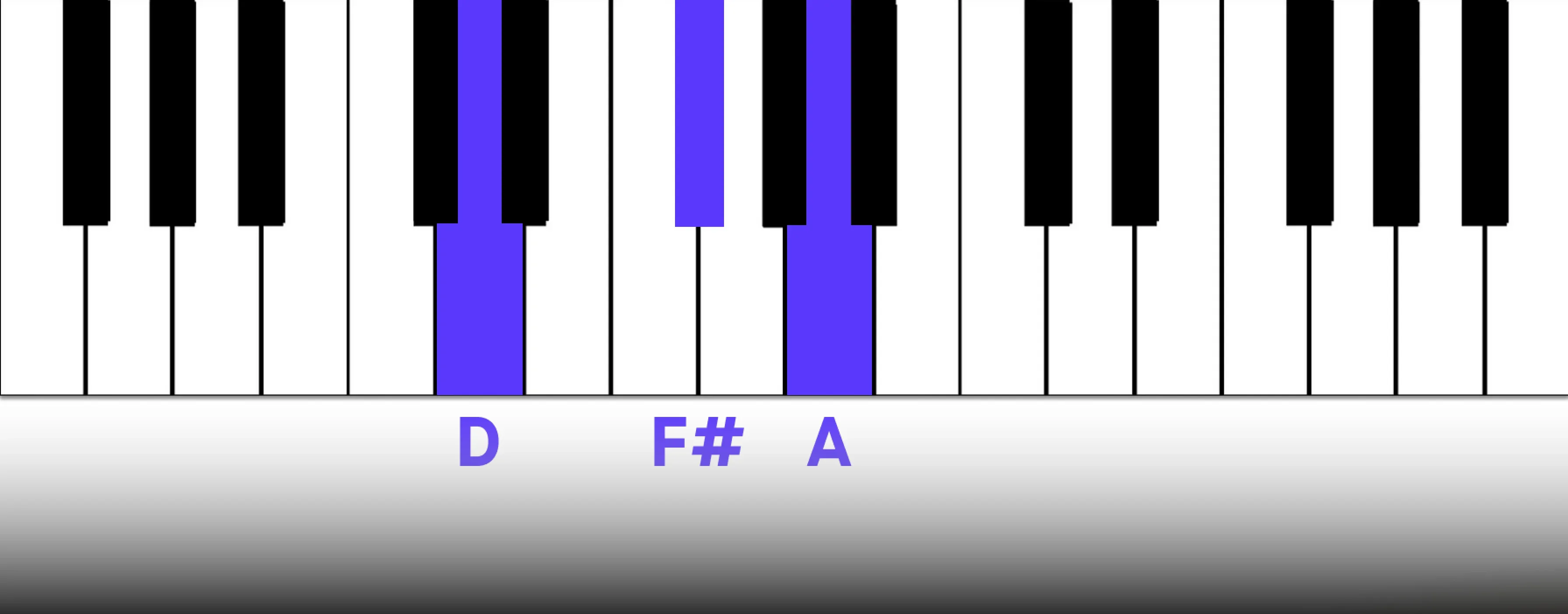
The subdominant, D major, is a crucial element in creating harmonic movement and providing a sense of contrast within the key of A major. Its function is to create a gentle pull away from the tonic, establishing a temporary point of harmonic interest. This pull is not as strong as the dominant, but it's enough to create a sense of anticipation and forward motion.
The subdominant's inherent tendency is to progress towards the dominant, setting up a classic and satisfying resolution back to the tonic. This movement from subdominant to dominant is a fundamental building block of tonal music, creating a sense of harmonic direction and closure.
Beyond its role in the basic I-IV-V-I progression, the subdominant can also be used to expand the harmonic palette, adding color and depth to progressions. It can create a sense of"departure"and"return", offering harmonic variety and enriching the overall musical experience.
Example: Coldplay's"Every Teardrop is a Waterfall"effectively demonstrates the expressive use of the subdominant chord. The shift from the tonic to the subdominant creates a noticeable harmonic departure, a feeling of moving away from the tonal center.
This movement adds depth and emotional nuance, often evoking feelings of longing or anticipation before the eventual return to the tonic. In this song, the subdominant likely contributes to the anthemic feel, creating a dynamic push and pull that resonates with the lyrics.
V: E Major
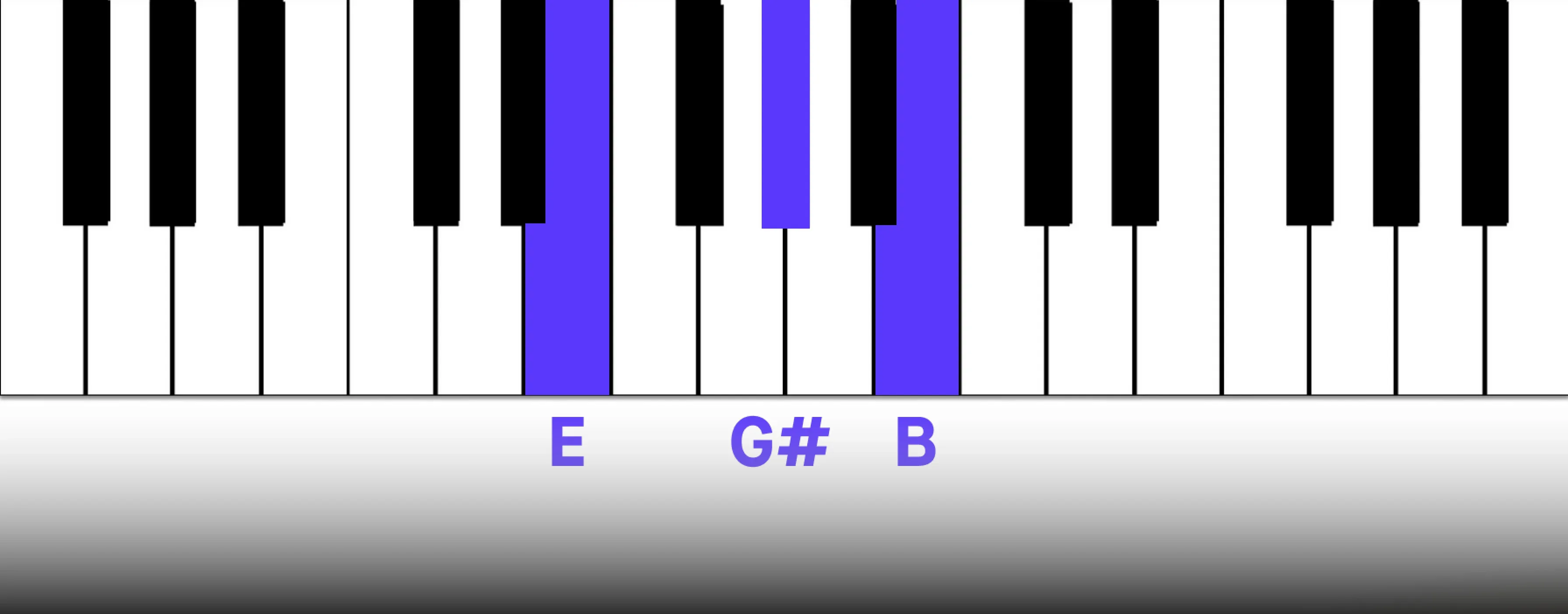
The E major chord as a dominant holds a particular position of importance. It's the point of greatest harmonic tension, the chord that most strongly yearns for resolution back to the tonic. Its primary function is to create this tension, acting as a powerful driving force that propels the music forward. As a major chord, it possesses a bright, assertive quality, but this brightness is coupled with a sense of instability. It's not a place of rest but rather a point of heightened energy, demanding release.
The dominant's role is crucial in defining the key and creating a sense of harmonic direction. It's the chord that makes the tonic feel like"home."While the dominant triad itself creates a strong pull towards resolution, the addition of a seventh (creating a dominant 7th chord) intensifies this pull even further, making the eventual return to the tonic even more satisfying.
The dominant 7th chord is so powerful that it can be used to temporarily"tonicize"any chord within the key through the use of secondary dominants. This technique adds complexity and color to harmonic progressions.
You can learn more about secondary dominants in this article. The dominant chord, whether in its triad or 7th form, is essential for creating harmonic drama, generating a sense of anticipation, and ultimately providing the satisfying resolution that defines tonal music.
Example: ABBA's "Dancing Queen"masterfully uses the dominant chord in the verse to create harmonic tension and anticipation. The prolonged emphasis on the dominant builds a desire for resolution.
The first time this occurs, the music returns to the beginning of the verse, prolonging the anticipation and creating a sense of expectation for a significant musical event. This delayed resolution heightens the impact of the subsequent arrival of the anthemic chorus, which provides the satisfying release of that built-up tension.
vi: F# Minor
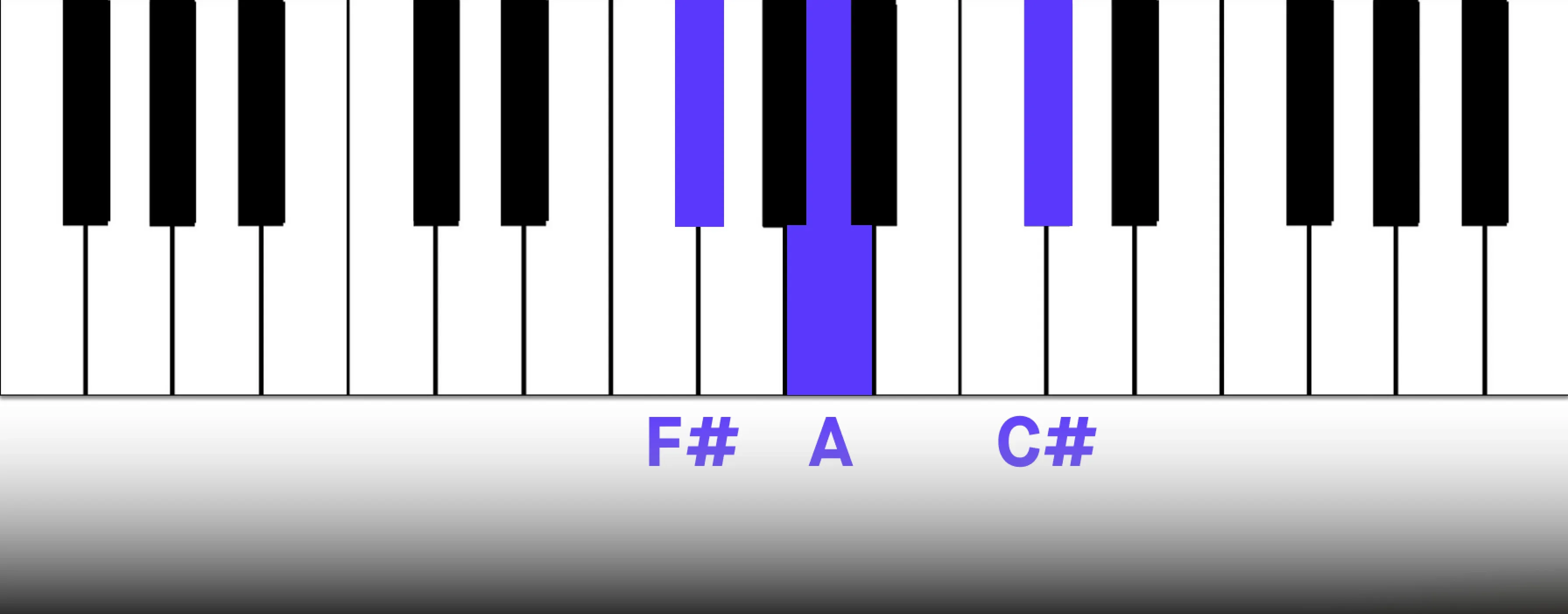
The F# minor brings a distinct, introspective quality to the harmony. Its minor tonality adds a touch of melancholy, offering a contrasting shade to the prevailing major mood. While not as functionally driven as the dominant or subdominant, it provides a moment of reflection that enriches the overall texture.
Notably, F# minor is also the tonic chord of the relative minor of A major. This relationship is significant because the relative minor shares the same key signature as its major counterpart but centers around a different tonal center.
The submediant's versatility allows for a range of applications. It can function as a passing chord, adding depth and color to progressions. It can also be used to create contrast, providing a moment of emotional weight before returning to the more stable major chords.
Example: Ed Sheeran's"The A Team"effectively utilizes the minor vi chord to enhance the song's emotional impact. This minor chord, in the context of the A Major tonic, contributes significantly to the song's melancholic yet hopeful atmosphere.
The interplay between the bright A Major and the more introspective F# minor creates a poignant tension and release, while the shared notes between the two chords maintain a sense of underlying harmonic coherence.
vii°: G#°
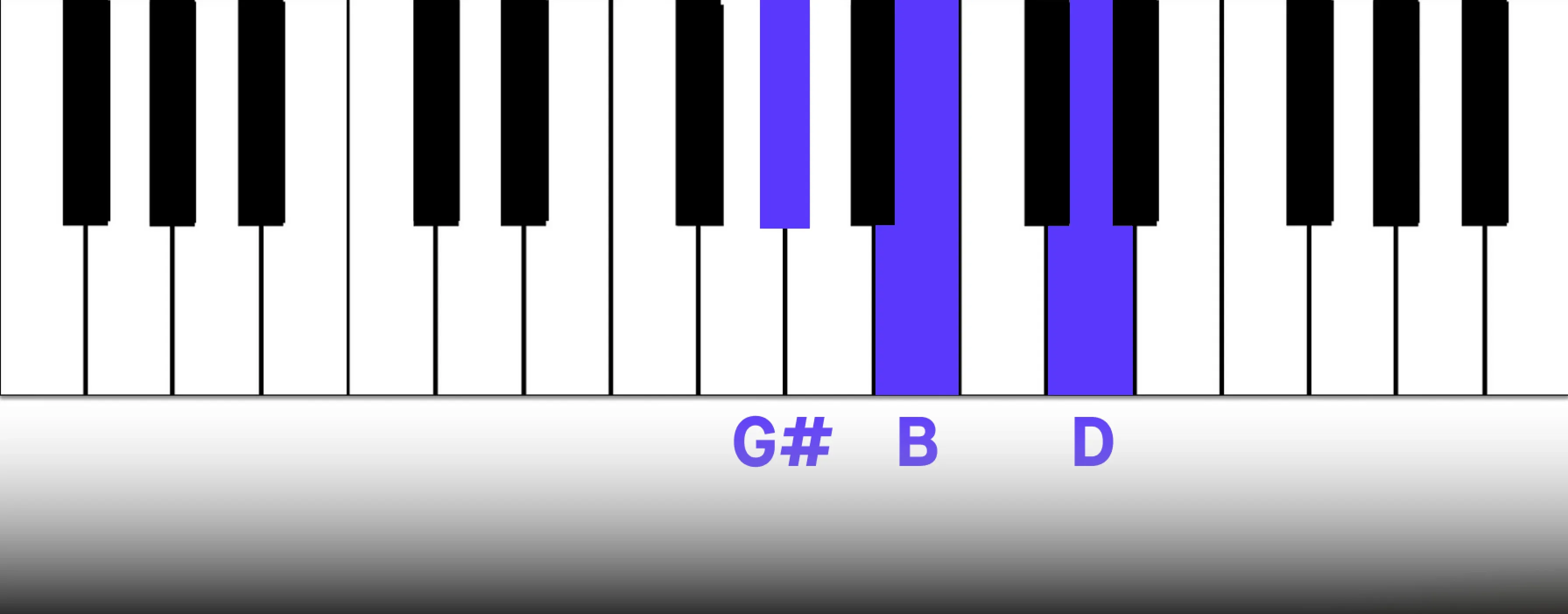
The G# diminished chord adds a unique and dramatic flavor to the harmony. As a diminished chord, it possesses a highly dissonant and unstable quality, creating a strong sense of tension and a powerful urge to resolve.
The diminished chord's unique quality stems from its construction: it consists of two stacked minor thirds, creating a tritone between the root and the fifth. This tritone is a highly dissonant interval that contributes to the chord's instability and its strong desire to resolve.
Because of its intense tension, the leading tone diminished chord is rarely used as a stable chord or a point of rest. Instead, it serves as a dramatic passing chord, adding a touch of heightened emotion and anticipation before resolving to the tonic.
In essence, the G# diminished chord adds a touch of drama, tension, and a strong sense of directed motion to the A major harmony, ultimately emphasizing the stability and resolution of the tonic.
These seven diatonic chords provide a solid foundation for building compelling progressions in A major. To get started on your next song, check out"30 Unique Songwriting Prompts to Craft Your Next Big Hit".
Adding Depth and Complexity to Chords in A Major
Seventh Chords in A Major
Seventh chords bring richness and depth to harmony, adding layers of complexity and color. They are constructed by adding an interval of a third above the fifth of a triad, resulting in a more nuanced and expressive sound. Here are the main types of seventh chords found in A major:
Using seventh chords allows for more intricate and emotionally resonant chord progressions, expanding the possibilities for expressive harmonic color.
For a more detailed guide on Seventh Chords in A Major, take a look at our article “A Comprehensive Tutorial on Creating Seventh Chords in A Major “.
Explore the diatonic and chromatic chords of A major in the following section, complete with audio and notated examples. If you're new to music notation, Music Matter's Grade 1 Music Theory course on YouTube offers an excellent introduction.
The Diminished Chord
Diminished triads are constructed with a root, a minor third, and a diminished fifth (a perfect fifth lowered by a half step). This diminished fifth creates a tritone interval with the root, a highly unstable and tense interval that gives diminished chords their distinctive sound.
This built-in tension makes diminished chords exceptionally expressive, capable of conveying emotions ranging from suspense and unease to drama and intensity, often by creating a strong pull toward a resolving chord.
Here is a chord progression using a borrowed chord diminished from the F# major scale to create a leading tone before arriving at the final chord of the progression.
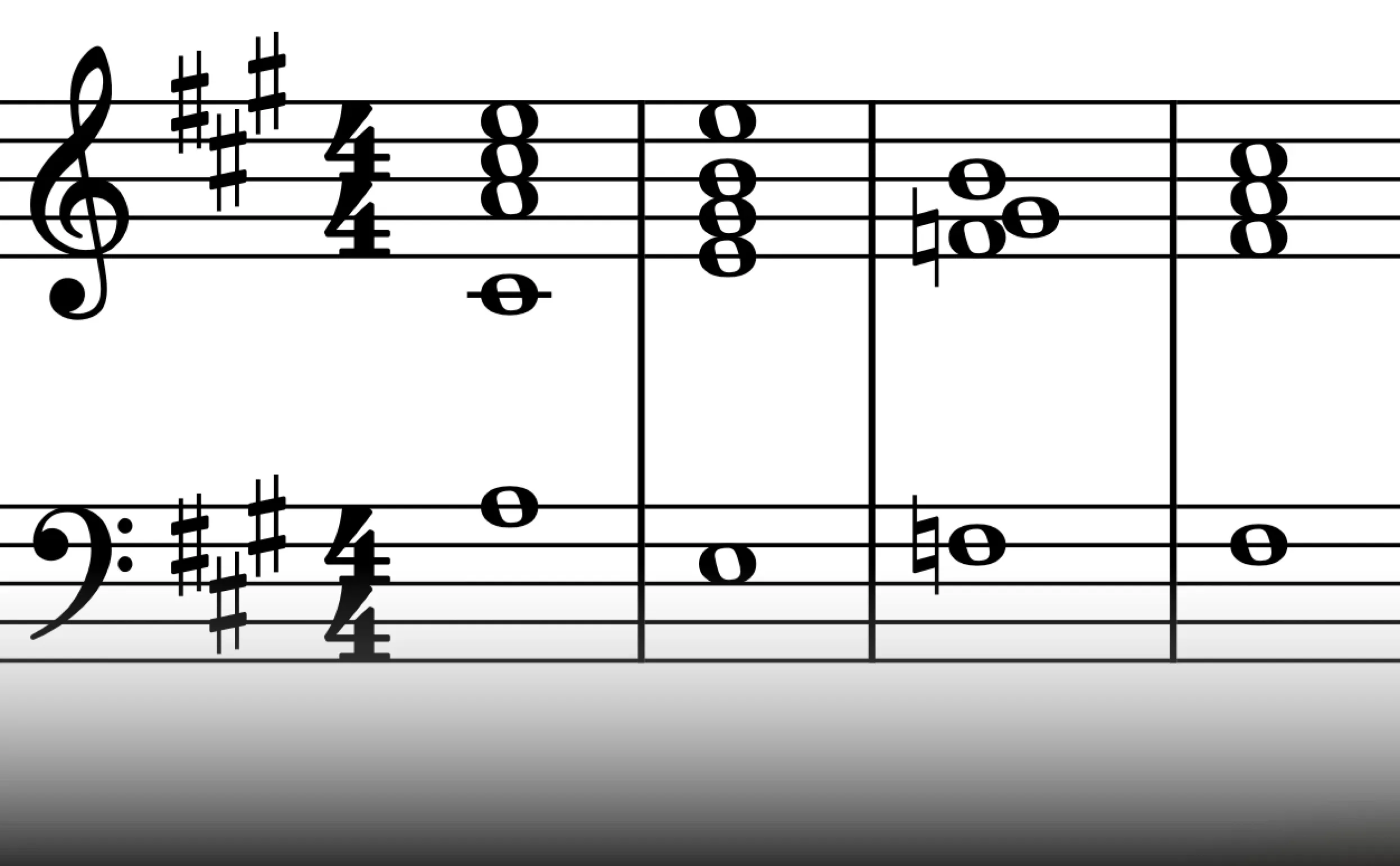
Chords: I (A) - V (E) - VII°/vi (F°) - vi (F#m)
Natural Occurrence Within Major Scales
As we’ve seen, diminished triads naturally appear within the A major key signature on the seventh scale degree. This diminished triad shares two notes with the dominant 7th chord, facilitating a smooth transition to the dominant and its subsequent powerful resolution to the tonic.
Functions of Diminished Chords
Diminished chords are powerful tools for creating dissonance, suspense, and drama in music, particularly within jazz chord progressions, where they are frequently used to generate tension and release, adding color and complexity to progressions.
While less prevalent in mainstream pop and rock, they still offer valuable expressive possibilities in those genres. Diminished chords serve two primary functions:
Adding Variety and Interest to Chord Progressions
Beyond their functional roles, diminished chords offer a wealth of creative possibilities for adding color and intrigue to harmonic progressions. One particularly effective technique is to diminish a normally major or minor triad, creating a momentary tension and surprise that injects harmonic interest. This unexpected shift briefly destabilizes the established harmony before typically resolving to a closely related chord.
This technique introduces subtle mood shifts and enhances the variety of otherwise standard chord progressions.
A solid understanding of diminished chord construction and harmonic function empowers composers to craft more compelling and emotionally resonant musical phrases with sophisticated harmonies.
The Augmented Chord
The augmented chord is formed by stacking two major thirds above a root, producing its distinctive dissonant sound. Since augmented triads aren't found naturally within the diatonic A major, their inclusion requires the use of chromaticism – notes outside the key.
Incorporating augmented triads alongside other chromatic elements empowers composers and songwriters to enrich their music with complexity, tension, and heightened motion. These additions facilitate unexpected harmonic shifts and generate a compelling need for resolution.
Augmented chords offer a range of expressive possibilities, from creating surprising harmonic shifts and facilitating smooth key changes (by acting as pivot chords, for example) to simply adding color and variety to the existing harmonic landscape.
Here is an example of the augmented chord on the tonic that resolves to the major IV chord.
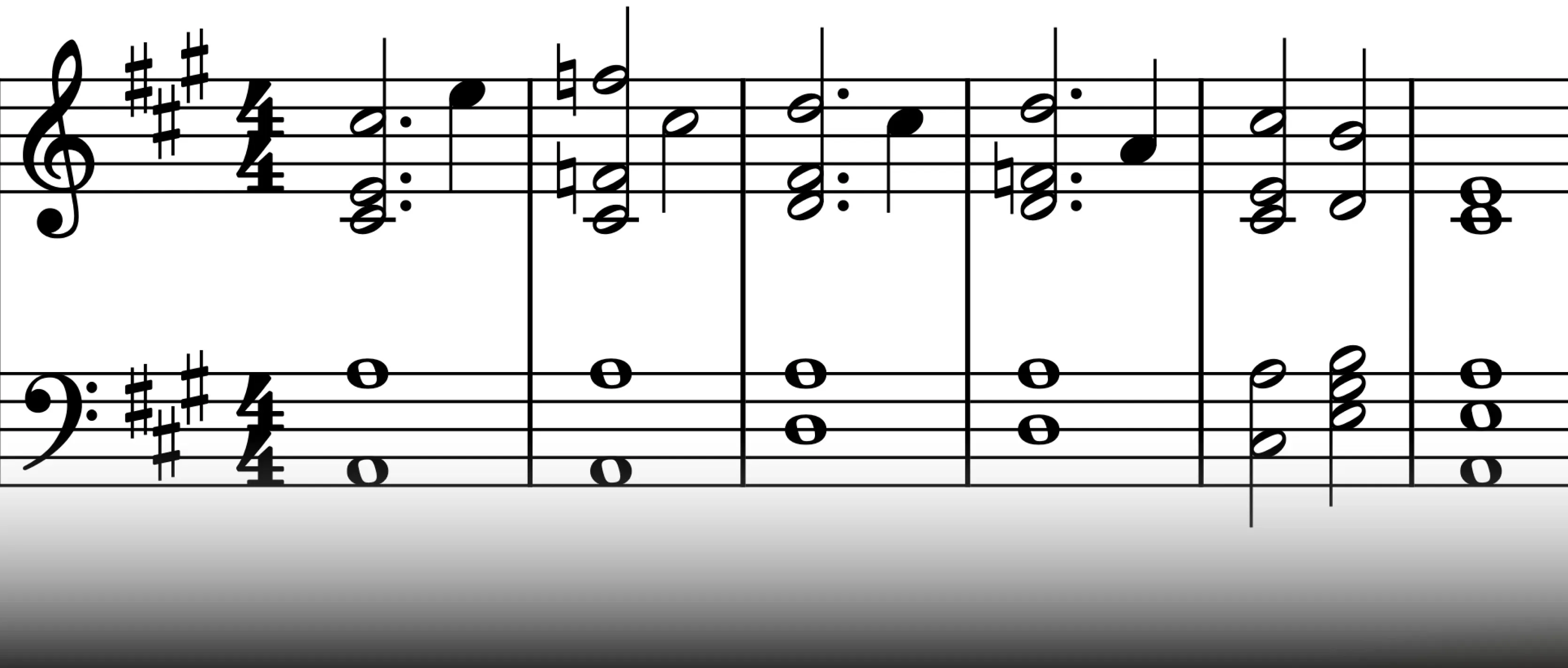
Chords: I (A) - I+ (A+) - IV (D) - iv (Dm) - I (A) - V7 (E7) - I (A)
The raised fifth of the augmented chord creates a unique tension, giving it an unresolved, ambiguous quality unlike that of dominant or diminished chords.
Augmented triads, though not diatonic to major or minor keys, can be strategically used to create moments of heightened tension and dramatic resolution. Two common harmonic applications showcase their unique character:
The following example demonstrates augmented chords resolving to chords containing a note a half step above the augmented fifth.
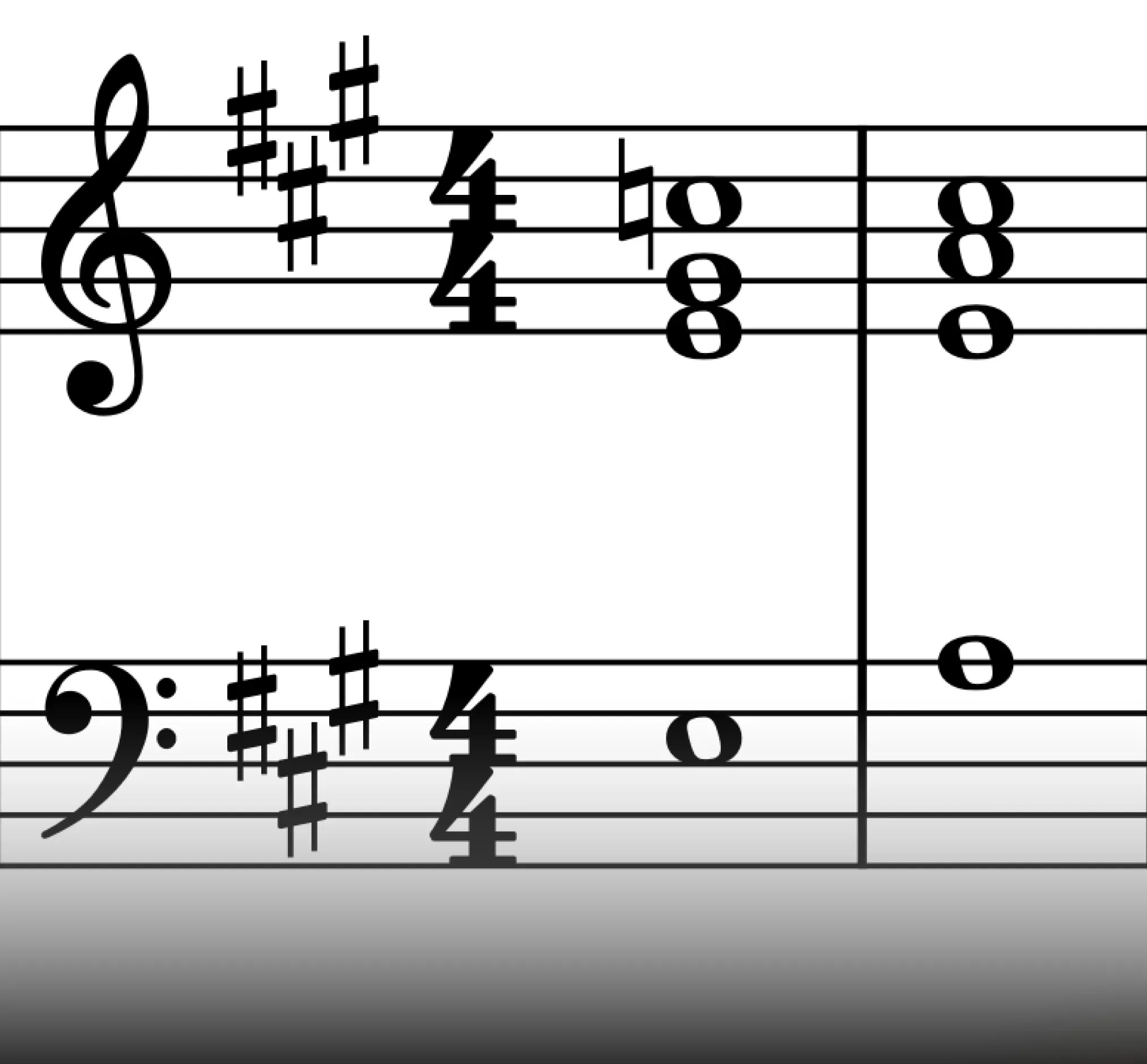
Chords: V+ (Eaug) - I (A)
Line Cliché:
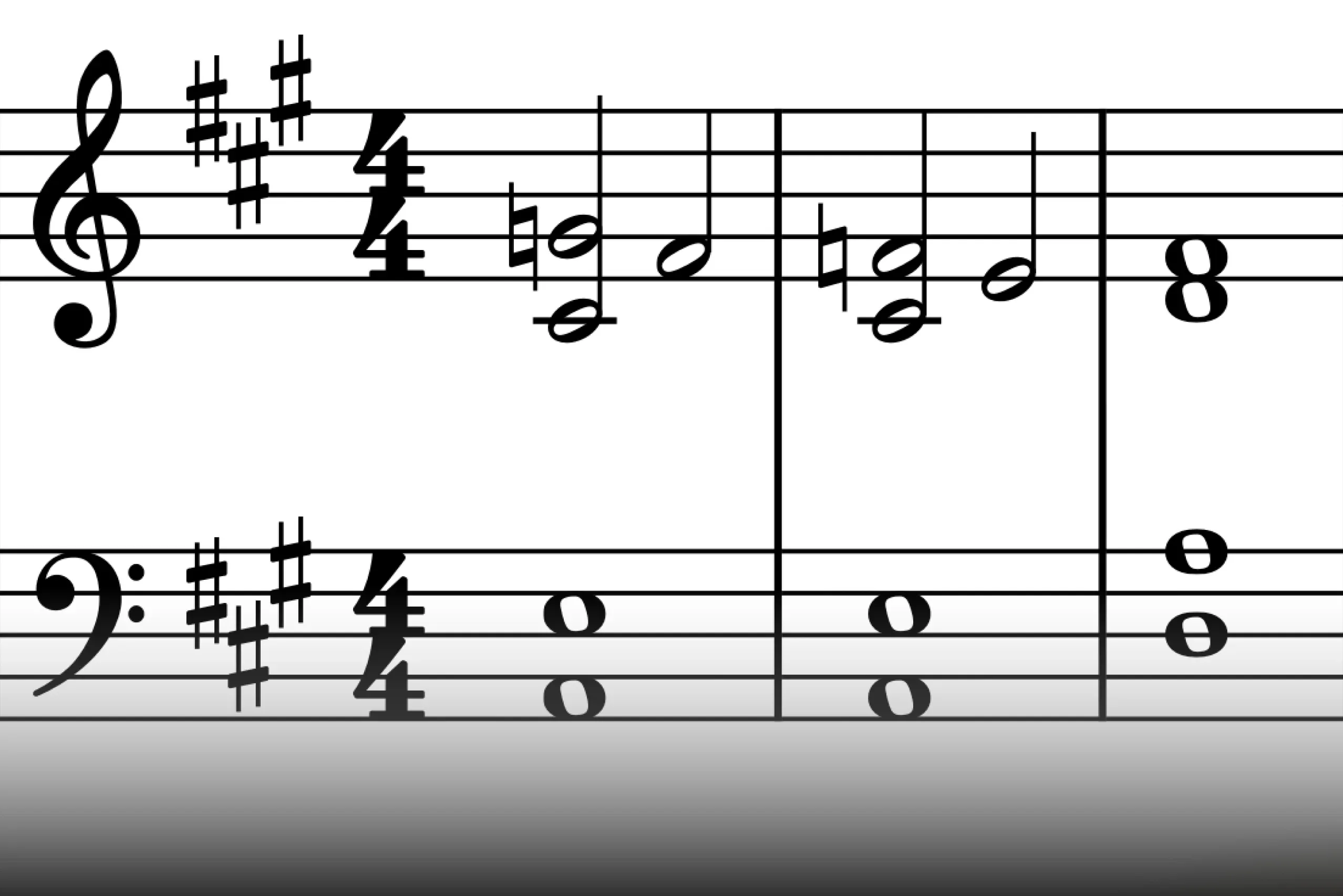
Despite their inherent instability, augmented chords offer several valuable musical functions:
Suspended chords: Beyond Major and Minor
Suspended chords, often called"sus"chords, create harmonic ambiguity by replacing the third of a major or minor triad with either the second or fourth degree of the scale. Replacing the third with the second creates a sus2 chord while replacing it with the fourth creates a sus4 chord.
Because the third defines a triad as major or minor, its substitution creates a sense of harmonic suspension – an unresolved tension – and a less defined tonal character compared to traditional triads. This ambiguity results in a unique harmonic color, lacking the clear tonal direction of typical triads.
This unresolved quality makes sus chords incredibly versatile for expressing a wide range of emotions and atmospheres. They can evoke ethereal and dreamy soundscapes, create moments of suspense and anticipation, or simply add a touch of harmonic intrigue. The feeling of anticipation inherent in sus chords allows composers to craft nuanced emotional effects, expanding the expressive possibilities of their music.
Sus chords serve several key functions in music:
- Creating suspension and anticipation: As their name suggests, sus chords excel at generating harmonic suspension and a sense of unresolved tension, making them effective in transitional passages, build-ups, or anywhere anticipation is desired.
- Adding color and texture: Their unique intervallic structure introduces subtle harmonic variations and nuances, enriching chord progressions and preventing monotony.
- Dominant prolongation: The sus4 chord built on the dominant degree is particularly useful for prolonging dominant tension. Unlike the standard dominant chord, the Vsus4 delays the tritone's resolution, increasing anticipation. The progression Vsus4-V-I is a classic way to create a satisfying resolution and effectively wrap up musical phrases. The Vsus4 adds a layer of anticipation before the final tonic resolution.
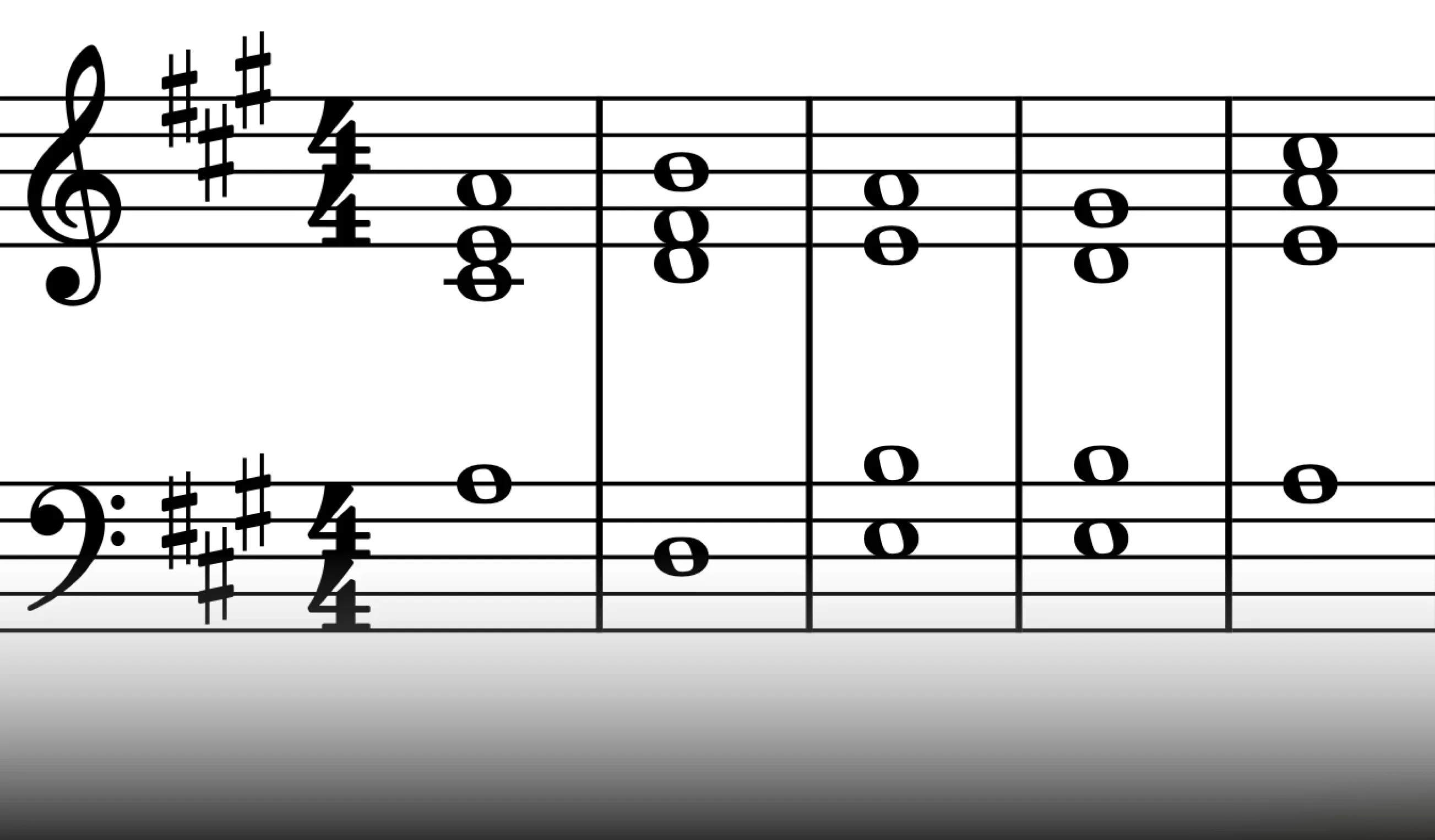
Chords: 6. I (A) - IV (D) - Vsus4 (Esus4) - V7 (E7) - I (A)
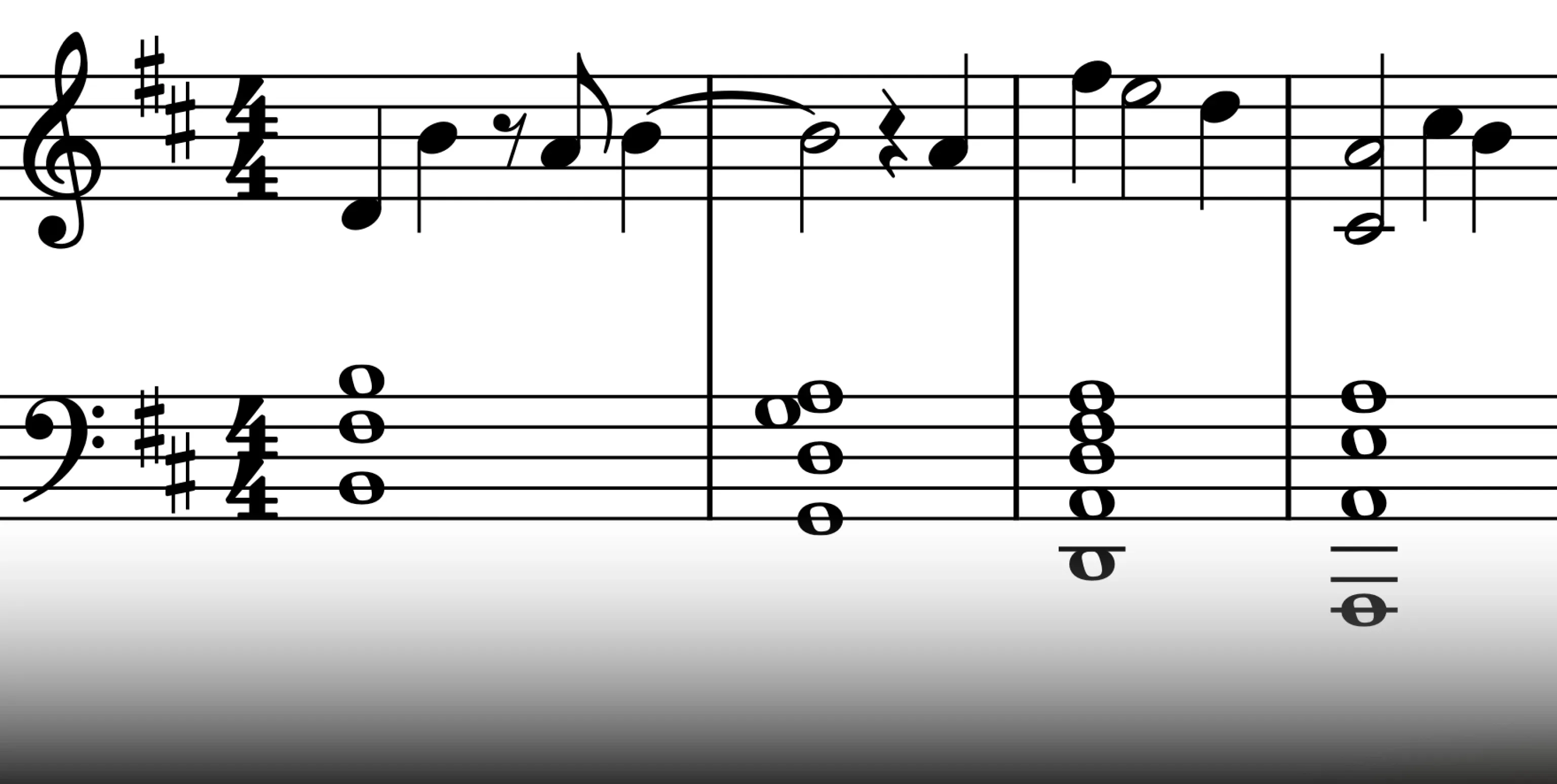
Chords: Isus2 (Asus2) - I (A) - iii (C#m) - V (E) vi (F#m) - iii (C#m) - iv (D)
Suspended chords bring a unique color and complexity to harmonic progressions. However, their emotional impact is highly dependent on context, shaped by surrounding harmonies, instrumentation, and tempo.
A sus4 chord in a slow, quiet passage might evoke yearning, while the same chord in a fast, loud passage could generate anticipation.
While both sus2 and sus4 chords create harmonic suspension, their resolution tendencies differ. The sus4, with its perfect fourth interval, strongly gravitates toward a resolution to the major or minor third.
The sus2, with its major second interval, is less"tense"and often functions more independently, not requiring the same strong resolution as the sus4. It can impart a more open, airy quality to the harmony.
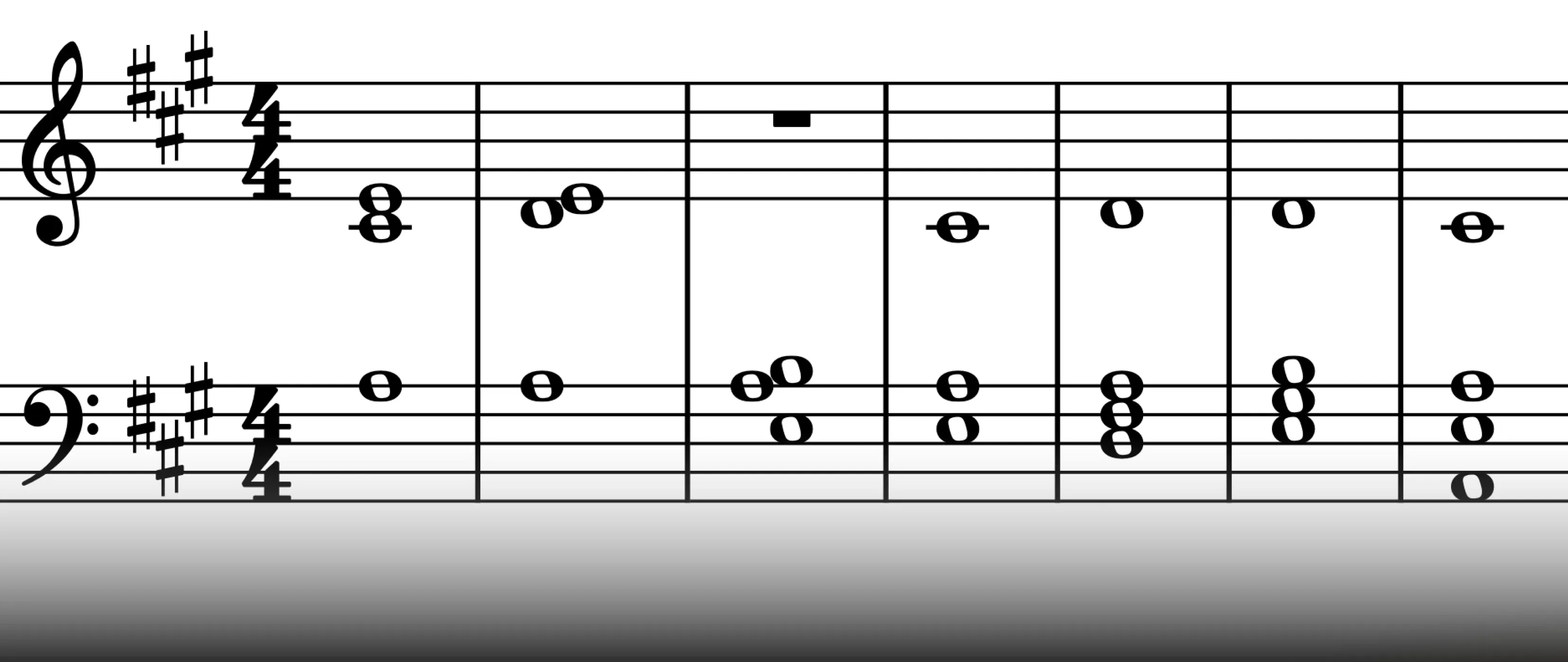
Chords: I (A) - Isus4 (Asus4) - Vsus4 (Esus4) - I (A) - IV (D) - V7 (E7) - I (A)
A deep understanding of suspended chords unlocks a wealth of creative potential for musicians of all genres. By grasping their formation, sonic qualities, and diverse applications, you can add depth, color, and intrigue to your compositions.
Power Chords
Power chords are essential to rock music, providing its raw energy. These simplified chords, typically consisting of just the root and fifth (sometimes with an octave doubling the root), deliver a punchy, versatile sound that forms the genre's backbone.
Their stripped-down structure creates a powerful and unambiguous sonic impact that we hear in rock chord progressions. This simplicity allows them to function effectively in various melodic and harmonic settings, making them a natural fit for high-energy music and a fundamental part of rock chord progressions.
Because distorted guitar is a hallmark of rock, power chords are instrumental in creating its signature sound. The absence of the third (the note that defines a chord as major or minor) is crucial.
It eliminates potential harmonic clashes and unwanted dissonance that distortion would exaggerate and muddy, allowing the powerful root and fifth to cut through the mix.
Beyond their sonic advantages, power chords are incredibly player-friendly, especially on guitar. The consistent hand shape and straightforward movement across the fretboard make them accessible and efficient for building powerful riffs and progressions.
Chord Inversions
Chord inversions occur when a chord tone other than the root is placed in the bass. This simple shift can dramatically alter a chord's character, as the bass note strongly influences the harmony's overall sound and feel.
These inversions can significantly impact a chord progression's sound and feel, adding smoothness, variety, and harmonic interest. The following section explores why chord inversions are used beyond basic triads.
Smooth Voice Leading
A chord's inversion is determined by which note is in the bass, but its overall sound and feel are also shaped by its voicing—the specific arrangement of all the notes. The intervals created between the notes within a given voicing influence the chord's color. Even within the same inversion, rearranging the notes can subtly alter the chord's sonic character and sense of stability.
A primary reason for using inversions is to create a smoother voice leading between chords. By minimizing leaps between individual notes in successive chords, inversions facilitate a more stepwise, connected, and pleasing musical texture.
This fluid harmonic flow is particularly important in larger arrangements, where smooth voice leading prevents muddiness in the lower register and ensures individual parts blend well for a cohesive and polished sound.
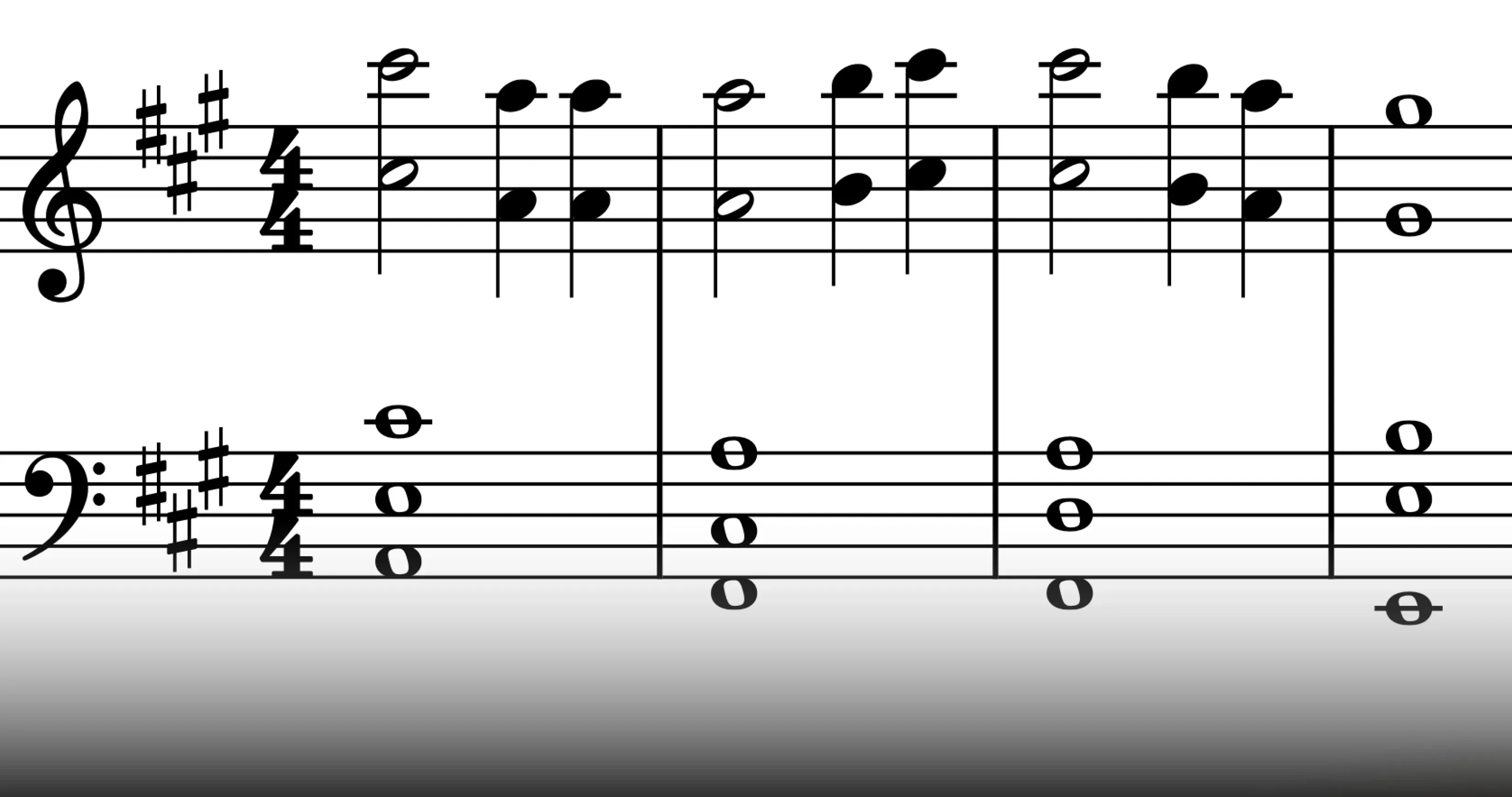
Chords: I (A) - vi (F#m) - IV (D) - V (E)
In multi-instrumental writing, careful attention to voice leading is crucial. Good voice leading, by minimizing large leaps and unwanted dissonances, contributes to balanced and clear textures, ensuring each instrument effectively contributes to the overall harmony.
Stability and Sound
Chord inversions subtly alter a chord's stability and sonic character by changing the relationship between the bass note and the other chord tones. This adds expressive depth and variety without introducing dissonance.
Root position chords, with the root in the bass, project a sense of grounded stability. Inverted chords, having a different note in the bass, can create a feeling of motion or a less resolved quality, offering harmonic variety without harshness.
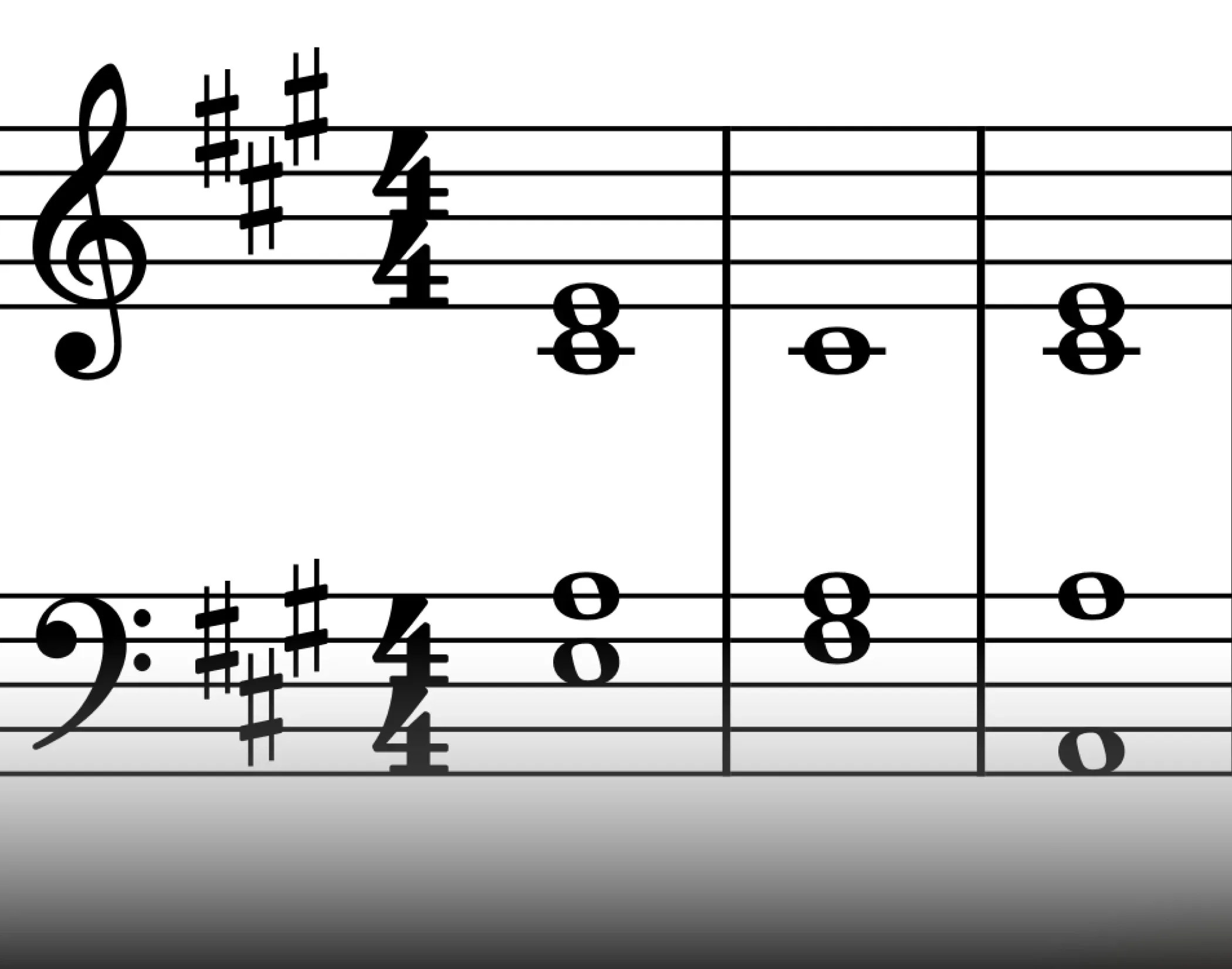
Chords: A/E - F#m - A
Using inversions of the tonic chord is a powerful technique for creating nuanced approaches to harmonic stability and reinforcing the home key. Different inversions offer varying degrees of stability, allowing subtle control over the sense of resolution and arrival.
Beginning or ending phrases with inverted tonic chords add sophistication and avoid the feeling of constant resolution, allowing for more fluid harmonic movement.
For example, a piece might begin with the tonic in root position, establishing a strong sense of stability. Subsequent use of the tonic in different inversions subtly alters the harmonic color and character.
The first inversion might create a more flowing feel, while the second could add a touch of lightness. This adds depth and interest while firmly grounding the tonal center. Chord inversions bring subtle nuances and richness to harmonies.
By offering varying degrees of stability and a wider range of bass line options, they unlock a broader palette of voicings and textures, leading to a more dynamic and engaging listening experience.
Learn How to Recognize Intervals
Developing your interval recognition skills is essential for working with triads, inversions, and altered chords (diminished, augmented, or suspended). The ability to quickly identify intervals streamlines songwriting, enabling more intentional choices and reducing trial and error when selecting chords or melody notes.
For example, recognizing a melody moving up by a perfect fourth allows immediate identification of potential chord tones or the creation of harmonizing parts.
Training your ear to distinguish each interval gives you greater control over your music, enabling more efficient writing, informed harmonic decisions, and, ultimately, more effective expression of your musical ideas.
Our article, “Ear Training: Songs to Practice Intervals”, offers a curated list of songs for practicing both ascending and descending intervals to help you develop this crucial skill.
What’s next?
Discover how to craft unique and compelling chord progressions with the help of our article “Mastering Chord Progressions in A Major: A Complete Guide”. We explore how A major chords are used in popular music and delve into interesting harmonic techniques to elevate your songwriting.
This in-depth exploration of A major harmony examines the effective use of both diatonic and chromatic chords, drawing inspiration from popular song analyses.
Learn how to add intrigue and flavor using techniques like tonic substitutions, secondary dominants, chromatic mediants, and other devices that create unexpected harmonic shifts to captivate your listeners. The guide also touches on modulation (key changes) to further enhance the musical journey.
Musiversal: For Musicians, by Musicians
Take your music to the next level with unlimited recording sessions and access to a network of over 80 professional session musicians and engineers. Our Unlimited plan provides everything you need.
Find the ideal musicians for your project – from drummers and cellists to guitarists, pianists, wind players, bassists, beatmakers, and many more. Simply select a convenient time from their availability and join your live recording session through a dedicated link. Experience your music come alive as you collaborate with the musician in real-time.
If you haven't finished your song yet, we offer songwriting services, production advice sessions, and even introductory meetings with artists to discuss your project and recording process. Our engineers also provide professional mixing and mastering to polish your tracks.
To help you reach a wider audience, we offer marketing sessions to get your music heard.
For valuable information on music theory, songwriting, creativity, production, gear, marketing, and distribution, explore the weekly Musiversal Blog.
Subscribe to our newsletter for exclusive Musiversal discounts, inspiring session highlights, helpful marketing tips, and more!
Your Music, No Limits.
Join the Waitlist